Gabe Vargo: Blending Professional Expertise with Personal Passion
by Victoria Parsons
Fascinated by raptors as an undergraduate at the University of Miami, Gabe Vargo became an apprentice falconer before going on to earn a Ph.D. in biological oceanography. Now an associate professor at the University of South Florida’s College of Marine Science specializing in the population dynamics of phytoplankton — or what happens to algae when conditions around them change — he’s been studying the effects of toxins produced by algae on birds for more than 20 years.
 |
Gabe Vargo
Associate Professor
USF College of Marine Science
|
Watching birds is not just for the birds, he notes. Birds are the early warning system in our ecosystem (literally the canaries in the coal mine), particularly as harmful algal blooms seem to be increasing both in frequency, intensity and, perhaps, toxicity.
“As we learned with the movement of DDT back in the ‘50s and ‘60s, if it’s found in the top predators, it’s also found in humans,” he said. And while red tide gets the headlines, harmful algal blooms – or HABs – are common in fresh water as well. An occasional human or farm animal may be harmed, but birds seem to be impacted first.
One new toxin produced by a blue green algae has been linked to a disorder that is causing holes in the brains of raptors in six southern states, Vargo said. “We don’t have a direct link between the algae and the disorder but it looks like coots and other ducks eat the algae growing on other plants and then it moves up the food chain to raptors like hawks and bald eagles.”
Since scientists believe that the algae is carried from one waterbody to another on the feet of migrating birds, it’s just a matter of time before it arrives in Florida, he said. “We’re seeing an increase in the number of phytoplankton species that produce these toxins and now that we have finally started to investigate the cause of death in birds of all types, an increase in the number of deaths may be related to toxins.”
He began blending his professional expertise with his personal passion for birds when Karen Steidinger, then a scientist at the Florida Fish and Wildlife Research Institute, “twisted my arm” to start studying the impacts of red tide on seabirds.
He’s now supervising two graduate students completing the first in-depth study of levels of K. brevis toxins in dead birds. “They’re looking at how much toxins they have in their bodies when they died,” he said. “We’re working with the local rehabilitators who give us their birds for necropsies and trained volunteers who walk beaches in Pinellas and Manatee counties.”
Professionally, he’s deeply involved with cutting-edge research on the impact of nutrients on red tide, directing the lab work that provides detailed analyses of samples collected monthly at 67 offshore sites between Tampa Bay and Charlotte Harbor.
As a volunteer, he helps care for non-releasable raptors at Boyd Hill, including regular show-and-tells for local schoolchildren. Working with Tufts University, he coordinates Florida activities for the Seabird Ecological Assessment Network (SEAnet). Through Audubon, he directs the volunteer Eagle Watch in Pinellas County. “There are 16 active nests in Pinellas and we keep an eye on most of them,” he said. Even in the state’s most densely populated county, bald eagles have rebounded dramatically since DDT was banned, with nests in some of the county’s busiest corridors and even in a cell phone tower.
“They’re mostly successful,” he says. “They’re one of those species that seem to be okay in an urban setting.”
And while Vargo will probably retire from his professional position in 18 months, he’s not planning to step back from his volunteer work. “For my second career, I’m going to help SEAnet expand in Florida and participate in more educational programs that involve children with birds,” he said. “We’ve got to get to the kids as young as possible to build environmental ethics in the next generations.”
Back to Top